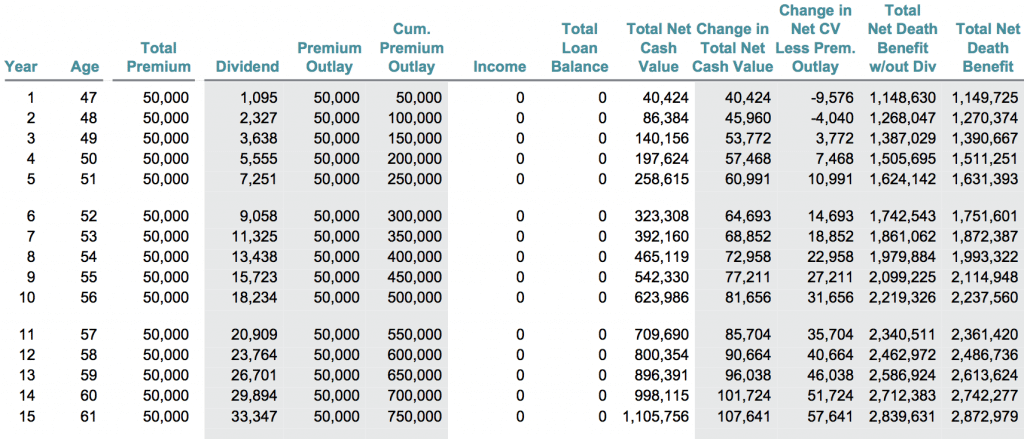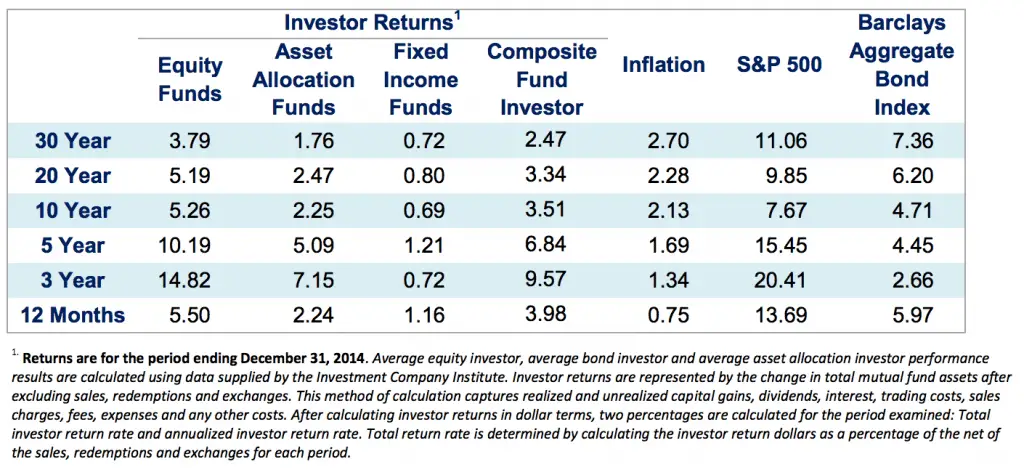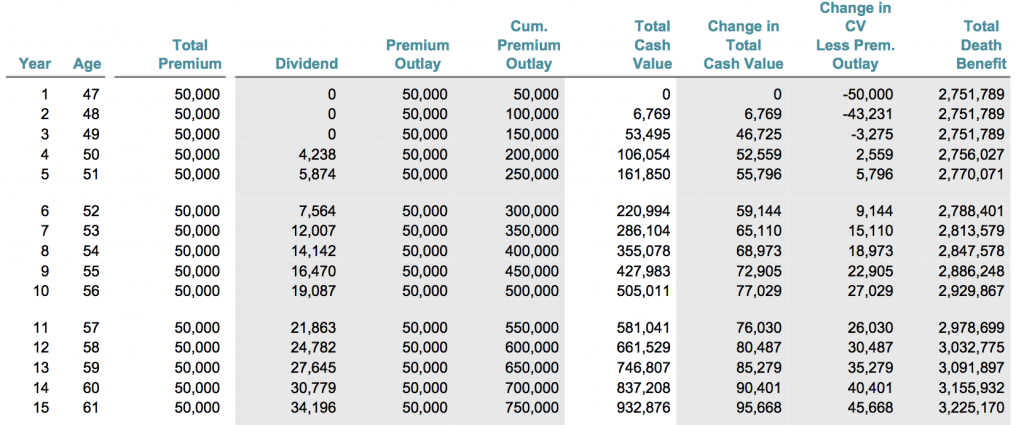Next up in our installment of arguments against permanent life insurance is the notion that returns are negative in the beginning and the good stuff simply takes too long to materialize.
If you look at a life insurance proposal ledger, you’ll notice that there is indeed a negative return during the early years. The length of this negative return depends a lot on how the policy is structured. In later years, though, returns are quite favorable compared to adequately risk exposed savings/investment options.
Here’s an example of a typical ledger for a whole life policy we would design:
As you can plainly see the rate of return during the first 4 years is definitely negative as the policy cash value is less than the aggregate premium paid to the policy.
Beginning in year five, however, cash values exceed aggregate premiums and by year 15 the policy has an effective annualized rate of return of 4.71%. That means in order to get that same amount of cash value for all of the entire premiums paid, one would need to earn 4.71% per year from year one to year 15.
That’s certainly not terrible given what one can expect out of bonds, CD’s, money market accounts, etc. It’s also not far behind what the average equity fund investor has achieved for a similar time period and way higher than the average fixed income and allocation fund investor has achieved according to DALBAR.
Here’s a chart from DALBAR’s Quantitative Analysis of Investor Behavior for 2015.
An Argument that Makes no Sense
This argument takes support from some seriously flawed logic. The suggestion is because you don’t start off with a positive return and because it can take a few years to achieve a positive return, permanent life insurance is a bad idea. It is commonly followed around by the thought crippling admission that after owning a permanent life insurance policy for a few years, it’s likely worth keeping.
So why would owning a product for a few years make it worth keeping if one shouldn’t own it in the first place?
It seems odd that while patience often finds it place among the good behaviors list for investing and financial planning, that behavior is oddly discouraged when it comes to whole life insurance or universal life insurance.
I bought a new house recently. There’s no way I could sell it now or likely even a year from now and walk away with a gain. Perhaps it was a terrible investment. Or maybe I’m just a crappy real-estate investor.
Evaluation in a Vacuum
∞∞∞∞∞∞∞∞∞∞∞∞∞∞∞∞∞∞∞∞∞∞∞∞∞∞∞∞∞∞∞∞∞∞∞∞∞∞∞∞∞∞∞∞∞∞∞∞∞∞∞∞∞∞
“When you stop evaluating life insurance in a vacuum you agree with the naysayers less and less” ~ Quote from a client of ours.
∞∞∞∞∞∞∞∞∞∞∞∞∞∞∞∞∞∞∞∞∞∞∞∞∞∞∞∞∞∞∞∞∞∞∞∞∞∞∞∞∞∞∞∞∞∞∞∞∞∞∞∞∞∞
This argument, much like the others, is either an intentional or careless misapplication of life insurance for the purpose of using it as a cash savings strategy. I wouldn’t recommend anyone with need for all of the money in a year or two buy a life insurance policy at this point in their life. I’ve turned away several who fall into this category.
But just because we can find a fact-pattern for whom life insurance isn’t recommended doesn’t mean it’s universally bad. Using that approach, we could determine everything is a bad idea.
Life insurance affords several great benefits and can be quite powerful when matched to the correct circumstances.
There is however one circumstance that gives this argument a tad more wind beneath its wings.
Death Benefit Focused Sales for Cash Value
Life insurance is a highly customizable product. This awesome flexibility can also be disastrous when left in the hands of a lesser skilled or wrongly intentioned insurance agent. There are those who try to present (and often hard sell) whole life insurance and/or universal life insurance as a savings plan but completely miss the mark in terms of proper policy design.
Here’s an example comparing a poorly implemented policy to the one I already shared above:
As you can see these results are far less impressive. Instead of achieving a positive return in five years, it takes this design 10. And by year 15 the annualized return is a far less impressive 2.68%. Still not absolutely terrible given the current interest rate market, but we know we can achieve far better results.
I should also note that this is the same product issued by the same company with the same insured and same premium outlay. The only difference is how they are designed.
The earlier example (our design) is a highly customized policy tweaked to ensure optimal cash performance. This example here is an off-the-shelf approach making little to no use of the customization afforded to life insurance agents/brokers. The intention behind this policy here is more death benefit than cash accumulation, so it’s fair to say this is a misapplication of the product when sold to someone seeking optimal cash value performance.
I want to be clear in pointing out that this doesn’t make the company or the product bad. It simply makes the execution bad.






Of course the death benefit is different in your two examples. One isn’t necessarily better than the other, it just depends on your life insurance needs.
Hi! Just started reading your blog!
I have a whole life insurance and I think it’s been built in a similar way to your 2nd example. It is taking forever to build up cash value.
I heard about IBC a while ago but am just starting to look into it. Not sure if I’m understanding it coorectly. In any case, from my understanding this insurance is built like your 1st example?
I’m hesitant to get another insurance since my premium for the one I have is already pretty high.
Thanks for your time.
Happy early New Year!
Hi MP,
IBC intended policies should more closely reflect the first example, but not all do (this is often due to agent inexperience or greed).
If the policy is taking any longer than 5-8 years to have a positive return, there’s a good chance you are correct about your policy’s not being designed correctly for cash accumulation purposes.